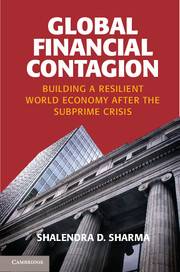Book contents
- Frontmatter
- Contents
- List of Figures
- List of Tables
- Acknowledgments
- Introduction
- One The United States
- Two The Bush and Obama Administrations’ Response
- Three From the U.S. to the European Crisis
- Four The Eurozone’s Sovereign-Debt Crisis
- Five Russia
- Six China
- Seven Japan, South Korea, and India
- Eight The Middle East amid the Global Financial Crisis
- Nine The Great Recession and the World’s Poorest
- Ten G-20 World
- Bibliography
- Index
Eight - The Middle East amid the Global Financial Crisis
Published online by Cambridge University Press: 05 June 2014
- Frontmatter
- Contents
- List of Figures
- List of Tables
- Acknowledgments
- Introduction
- One The United States
- Two The Bush and Obama Administrations’ Response
- Three From the U.S. to the European Crisis
- Four The Eurozone’s Sovereign-Debt Crisis
- Five Russia
- Six China
- Seven Japan, South Korea, and India
- Eight The Middle East amid the Global Financial Crisis
- Nine The Great Recession and the World’s Poorest
- Ten G-20 World
- Bibliography
- Index
Summary
When the financial crisis first broke, the prevailing view was that the Middle East, or MENA, an economically diverse region that includes the oil-rich economies in the Persian Gulf and the resource-poor countries such as Egypt, Morocco, Syria, and Yemen, was either going to successfully weather the impact of the crisis or altogether escape it. The reasons for the region’s supposed immunity varied. The oil-rich Gulf Cooperation Council (GCC) states, which together control 45 percent of the world’s oil reserves and 18 percent of the natural gas reserves, were awash with liquidity from skyrocketing oil prices (much of it invested in their “sovereign wealth funds” (SWFs), seemed well-sheltered from the fast-spreading contagion. Well-endowed SWFs such as the Kuwait Investment Authority (KIA) and the Qatar Investment Authority (QIA) were seen as having the capacity to continually boost liquidity and confidence in both the domestic and the regional economy. In fact, the GCC nations were seen as possible “shock absorbers” and “stabilizers” – their exceptionally strong economic positions giving them the ability to serve as both a potential cushion against the global downturn and as an engine pulling cash-starved economies from recession by providing desperately needed liquidity and supporting global demand. On the other hand, the economic backwardness and relative isolation of the hydrocarbon-poor countries from the global financial and capital markets (without the oil industry, the Arab world accounts for only 2.5 percent of world economic growth), was seen as their saving grace, a shield against the vagaries of global financial turmoil.
However, as Table 8.1 shows, after an initial period of calm and seeming resilience, the economic turbulence reached both the oil-rich and oil-poor MENA economies. Real GDP growth declined across the region, although, the forces behind the contagion and the impact were varied and uneven.
- Type
- Chapter
- Information
- Global Financial ContagionBuilding a Resilient World Economy after the Subprime Crisis, pp. 261 - 278Publisher: Cambridge University PressPrint publication year: 2013



